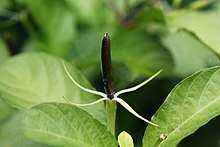Ruellia tuberosa
| Ruellia tuberosa | |
|---|---|
 | |
| A dry popping pod in a tree. | |
| Scientific classification | |
| Kingdom: | Plantae |
| (unranked): | Angiosperms |
| (unranked): | Eudicots |
| (unranked): | Asterids |
| Order: | Lamiales |
| Family: | Acanthaceae |
| Genus: | Ruellia |
| Species: | R. tuberosa |
| Binomial name | |
| Ruellia tuberosa | |
| Synonyms | |
Ruellia tuberosa, also known as minnieroot,[3] fever root, snapdragon root and sheep potato (Thai: ต้อยติ่ง), is a species of flowering plant in the Acanthaceae family. Its native range is in Central America but presently it has become naturalized in many countries of tropical South and Southeast Asia.[4]
Some butterfly species, like the lemon pansy (Junonia lemonias) and the mangrove buckeye (Junonia genoveva), feed on the leaves of Ruellia tuberosa.
Description and properties
It is a small biennial plant with thick fusiform tuberous roots and striking funnel-shaped violet-colored flowers. Its fruit is a 2 cm long sessile capsule containing about 20 seeds. Some of the names of the plant such as popping pod, duppy gun and cracker plant come from the fact that children like to play with the dry pods that pop when rubbed with spit or water.[5]
Ruellia tuberosa may be found in moist and shady environments. It grows, however, preferably in grasslands and roadsides —often as a weed in cultivated fields, and also in xerophile and ruderal habitats.[6]
In folk medicine[7] and Ayurvedic medicine[8] it has been used as a diuretic, anti-diabetic, antipyretic, analgesic, antihypertensive, gastroprotective, and to treat gonorrhea.[9] It is also used as a natural dye for textiles.[10]
See also
- 21540 Itthipanyanan, an asteroid named after the author of an award-winning study on Ruellia tuberosa
References
- ↑ "Ruellia tuberosa L. — The Plant List". www.theplantlist.org. Retrieved 16 March 2018.
- ↑ "RUELLIA TUBEROSA L. - MINNIEROOT". www.tropilab.com. Retrieved 16 March 2018.
- ↑ "Ruellia tuberosa". Natural Resources Conservation Service PLANTS Database. USDA. Retrieved 25 October 2015.
- ↑ "Yang Mekar ditamanku". mekarditamanku.blogspot.com. Retrieved 16 March 2018.
- ↑ Jeannette Allsopp, Dictionary of Caribbean English usage, University of the West Indies Press, 2003, ISBN 978-976-640-145-0
- ↑ (http://www.hear.org/pier/), Pacific Island Ecosystems at Risk project (PIER). "Ruellia tuberosa: info from PIER (PIER species info)". www.hear.org. Retrieved 16 March 2018.
- ↑ Graveson, Roger. "Ruellia tuberosa". www.saintlucianplants.com. Retrieved 16 March 2018.
- ↑ H. Panda, Handbook On Ayurvedic Medicines With Formulae, Processes And Their Uses, National Institute of Industrial Research, 2002, ISBN 81-86623-63-9
- ↑ Lans C.A., Ethnomedicine as used in Trinidad and Tobago for urinary problems and diabetes mellitus; J. Ethnobiol. Ethnomed. 200
- ↑ "Effect of Chitosan and Mordants on Dyeability of Cotton Fabrics with Ruellia tuberosa Linn" (PDF). cmu.ac.th. Retrieved 16 March 2018.
External links

- Ruellia, ruellia tuberosa, popping pod: Philippine herbal medicine
- Weeds other than plants
- Indian Medicinal Plants